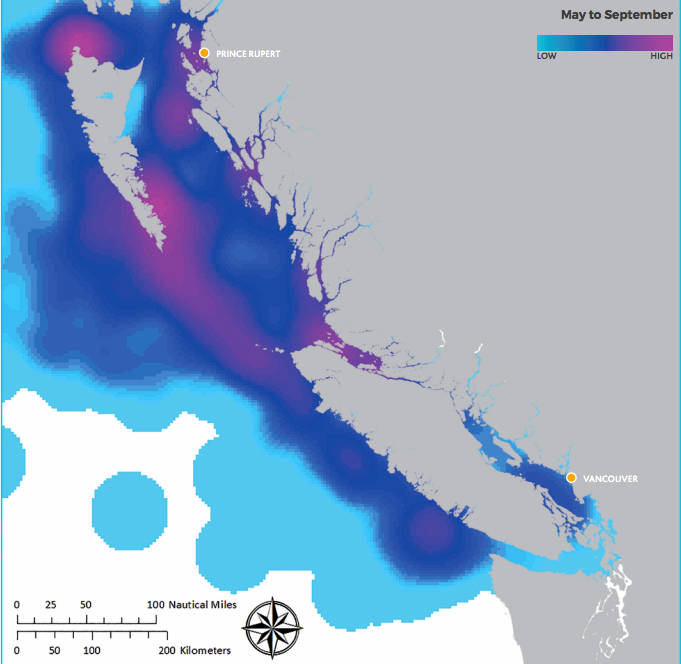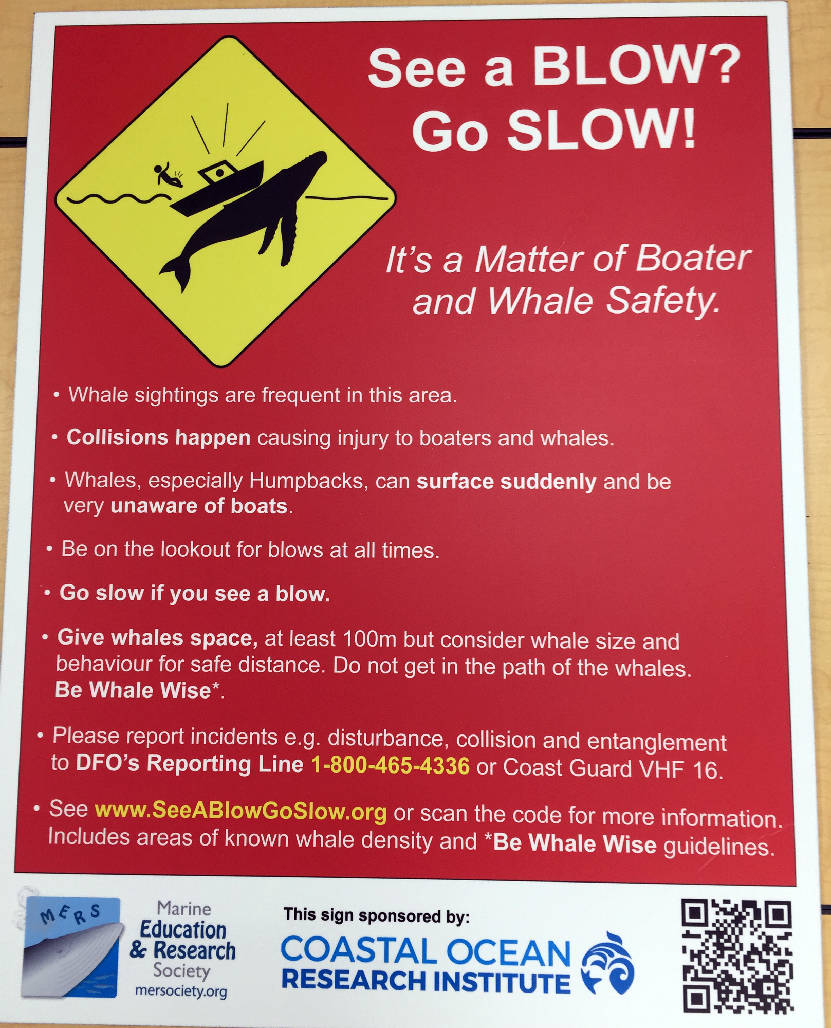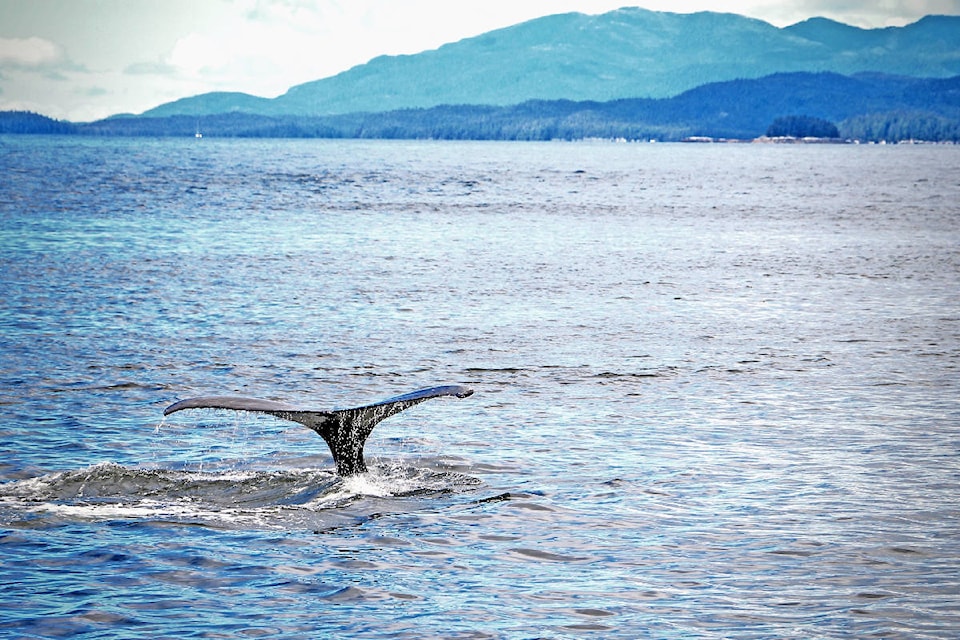Boaters need to be extra alert and ready to slow down for humpback whales and other cetaceans when fishing on the North Coast.
That’s a key message from the Marine Education and Research Society (MERS), which has launched a campaign to try and reduce the number of whale strikes along the B.C. coast.
Two people were seriously injured when their guided fishing boat suddenly struck a humpback whale in Virago Sound on June 25. No one on the boat had a chance to see the whale surface. They hit at a cruising speed of more than 20 knots.
“This is not an isolated incident,” Caitlin Birdsall said, who coordinates the North Coast Cetacean Research Initiative through Vancouver Aquarium.
Her colleagues at MERS on Vancouver Island have recorded two other strikes in June and there was an incident in Douglas Channel last year with a vessel.
“I think the best we can do right now is try and just make people aware that those whales are out there and they can surface unpredictably, they don’t always know where you are,” Birdsall said.
Both Birdsall and Jackie Hildering, a humpback researcher and society director at MERS, are seeing and hearing about more humpback whales on the North Coast. While their population increase is positive, they are also now moving into areas where people are less familiar with the cetaceans.
“The increasing number of humpbacks — the fortunate second chance with them — is a game-changer for boaters.”
Birdsall listed several factors as to why vessels are hitting humpback whales. While orcas have more predictable, linear movements and are surface active in summer feeding areas, humpbacks may be diving spread out and can surface without warning.
“I think those factors mesh together to make them a species that unfortunately is more vulnerable to strikes and for people more likely to hit accidentally with no knowledge that they’re there,” Birdsall said.
Unlike toothed whales, humpbacks and other baleen whales also lack biological sonar to warn them of approaching boats.
“They can be astoundingly oblivious to boats,” said Hildering, adding that she has had some close calls herself while researching humpbacks. When just under the surface, she said they can be tougher to see than a log.
Another factor is that this time of year, humpbacks are returning from Hawaii or Mexico, where there is little or no food for them and they’re so focused on feeding that they are less aware of their surroundings.
“They lose a huge amount of weight over the winter time and they come back and they are starving. They’re so focused on feeding that they’re really unaware of boats,” Birdsall said.
“They feed like crazy when they’re here, they’re taking long dives, and they’re usually travelling really rapidly.”
Given that behaviour, Hildering said it’s important boaters know where they can expect high densities of humpbacks, which very often return to the same feeding grounds year after year, as well as other cetaceans.
The “See a blow? Go slow” is the MERS campaign slogan, which also recommends boaters look for flocks of birds on the water as a sign whales may be feeding on schooling fish.
On the North Coast, the Cetacean Research Initiative has teamed up with MERS to share the message. Summer students started the campaign at Cow Bay Marina and will continue to visit other marinas in the area over the season to remind people where the popular humpback hot spots are.
In 2009, Fisheries and Oceans Canada identified the waters around Langara Island and southeast Moresby Island as two of the four critical habitat areas for humpbacks in B.C.
Only 30 cetacean-vessel strikes were reported to the BC Marine Mammal Response Network and investigated by DFO in the eight years between 2004 and 2011. One was a humpback hit near Langara Island, the other a humpback hit east of Skincuttle Inlet.
A cetaceans guide published earlier this year for mariners piloting large vessels — container ships, cruise ships, ferries — recommends speeds of 10 knots or less in areas with high densities of cetaceans.
On the Atlantic coast of the U.S., anyone piloting ships 65 metres or longer is legally required to travel under 10 knots in areas that tend to have many North Atlantic right whales — a change that has reduced strike-related deaths of the endangered species by 80 to 90 per cent.
Hildering said she and MERS are planning to visit Haida Gwaii next spring to talk about the issue and, hopefully, to put up some of the group’s whale-strike warning signs in areas where they might be helpful.
To report a whale strike, entanglement, or carcass at sea, call the B.C. Marine Mammal Response Network at 1-800-465-4336.
Sightings of whales and other cetaceans can be reported to the B.C. Cetacean Sightings Network at 1-866-I-SAW-ONE (1-866-472-9663)


